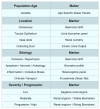Diagnostics, Risk Factors, Treatment and Outcomes of Acute Kidney Injury in a New Paradigm
- PMID: 32294894
- PMCID: PMC7230860
- DOI: 10.3390/jcm9041104
Diagnostics, Risk Factors, Treatment and Outcomes of Acute Kidney Injury in a New Paradigm
Abstract
Acute kidney injury (AKI) is a common clinical condition among patients admitted in the hospitals. The condition is associated with both increased short-term and long-term mortality. With the development of a standardized definition for AKI and the acknowledgment of the impact of AKI on patient outcomes, there has been increased recognition of AKI. Two advances from past decades, the usage of computer decision support and the discovery of AKI biomarkers, have the ability to advance the diagnostic method to and further management of AKI. The increasingly widespread use of electronic health records across hospitals has substantially increased the amount of data available to investigators and has shown promise in advancing AKI research. In addition, progress in the finding and validation of different forms of biomarkers of AKI within diversified clinical environments and has provided information and insight on testing, etiology and further prognosis of AKI, leading to future of precision and personalized approach to AKI management. In this this article, we discussed the changing paradigms in AKI: from mechanisms to diagnostics, risk factors, and management of AKI.
Keywords: acute kidney injury; acute renal failure; biomarkers; critical care; predictors; renal replacement therapy; risk factors outcomes.
Conflict of interest statement
We do not have any financial or non-financial potential conflicts of interest.
Figures
Similar articles
-
Controversies in paediatric acute kidney injury and continuous renal replacement therapy: can paediatric care lead the way to precision acute kidney injury medicine?Curr Opin Crit Care. 2021 Dec 1;27(6):604-610. doi: 10.1097/MCC.0000000000000888. Curr Opin Crit Care. 2021. PMID: 34561357 Free PMC article. Review.
-
Electronic health records accurately predict renal replacement therapy in acute kidney injury.BMC Nephrol. 2019 Jan 31;20(1):32. doi: 10.1186/s12882-019-1206-4. BMC Nephrol. 2019. PMID: 30704418 Free PMC article.
-
The Road to Precision Medicine for Acute Kidney Injury.Crit Care Med. 2024 Jul 1;52(7):1127-1137. doi: 10.1097/CCM.0000000000006328. Epub 2024 Jun 13. Crit Care Med. 2024. PMID: 38869385 Free PMC article. Review.
-
Short-term mortality in patients with cirrhosis of the liver and acute kidney injury: A prospective observational study.Indian J Gastroenterol. 2020 Oct;39(5):457-464. doi: 10.1007/s12664-020-01086-z. Epub 2020 Nov 11. Indian J Gastroenterol. 2020. PMID: 33175368
-
Neonatal Acute Kidney Injury.Front Pediatr. 2022 Apr 7;10:842544. doi: 10.3389/fped.2022.842544. eCollection 2022. Front Pediatr. 2022. PMID: 35463895 Free PMC article. Review.
Cited by
-
Development of a Mortality Prediction Model in Hospitalised SARS-CoV-2 Positive Patients Based on Routine Kidney Biomarkers.Int J Mol Sci. 2022 Jun 30;23(13):7260. doi: 10.3390/ijms23137260. Int J Mol Sci. 2022. PMID: 35806273 Free PMC article.
-
Acute kidney injury in diabetes mellitus: Epidemiology, diagnostic, and therapeutic concepts.FASEB J. 2023 Apr;37(4):e22884. doi: 10.1096/fj.202201340RR. FASEB J. 2023. PMID: 36943403 Free PMC article. Review.
-
Systematic review and subgroup analysis of the incidence of acute kidney injury (AKI) in patients with COVID-19.BMC Nephrol. 2021 Feb 5;22(1):52. doi: 10.1186/s12882-021-02244-x. BMC Nephrol. 2021. PMID: 33546616 Free PMC article.
-
Predictive Value of Anion Gap for Acute Kidney Injury Progression and Outcomes.Med Sci Monit. 2025 Jun 14;31:e947405. doi: 10.12659/MSM.947405. Med Sci Monit. 2025. PMID: 40515395 Free PMC article. Clinical Trial.
-
Development of mortality prediction model in the elderly hospitalized AKI patients.Sci Rep. 2021 Jul 26;11(1):15157. doi: 10.1038/s41598-021-94271-9. Sci Rep. 2021. PMID: 34312443 Free PMC article.
References
Publication types
Grants and funding
LinkOut - more resources
Full Text Sources
Miscellaneous




